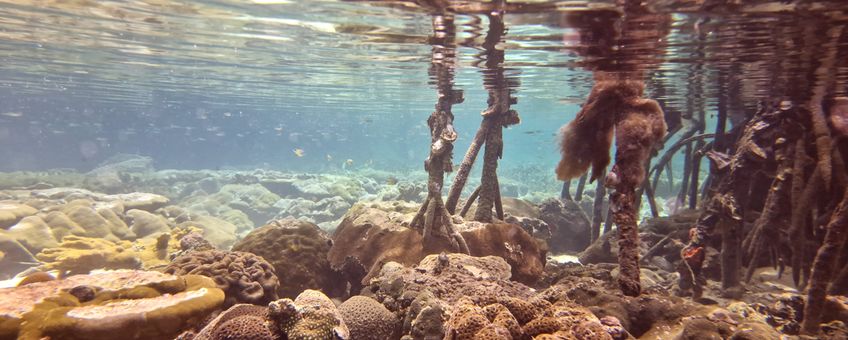
From plans to action: managing coral reef protection
Naturalis Biodiversity Center, Wageningen University & ResearchCoral reefs are not only very beautiful and extremely rich in biodiversity, but they also provide coastal protection and provide food and jobs for millions of people worldwide. Therefore, it is important to protect them. One of the common tools available for protecting coral reefs is creating a marine protected area (MPA). These are areas in the ocean that are set aside to protect coral reefs, fish, and marine ecosystems. Indonesia, a country that is recognised as a biodiversity hotspot within the coral triangle is taking action by rapidly expanding its network of MPA’s.
Turning vision into impactful action
A sixth of the world’s coral reefs are found in Indonesia. Unfortunately, these reefs are increasingly threatened by pollution, intensive fishery and climate change. Since the 1970’s Indonesia has created an increasing amount of marine protected areas to protect its marine ecosystems. By the end of 2021 there were 400 MPA’s covering 28.41 million hectares of ocean. The country aims to expand this area to 97.5 million hectares by 2045.
Agustín Capriati, PhD candidate at Wageningen University & Research and guest researcher at Naturalis Biodiversity Center, believes there is still room to improve most management plans for these marine protected areas. “On paper, MPA’s are a great idea and it’s uplifting to see the Indonesian government, like many others, showing a strong commitment to ocean protection. While many of the current MPA management plans are still developing, this offers a valuable opportunity to build on them and turn vision into impactful action.”
A national park with no rangers
Capriati worked together with an international team of researchers, practitioners from the government and conservation NGOs to check how well Indonesia’s management plans for marine protected areas account for the stress factors that impact coral reefs. The team reviewed management plans for all 400 Indonesian MPA’s, of which only a fifth had complete management plans. “In many cases, threats like overfishing, pollution or warming waters due to climate change are listed and acknowledged as a big pressure on reefs, but the plans do not always include strategies to deal with them.” The team found most management plans to be generic. “What’s missing for many marine protected areas is a connection between the problems identified and an action plan to actually solve these problems”, says Capriati.
Management plans that lack site-specific and targeted actions can fall short of delivering meaningful conservation outcomes and may also result in inefficient use of resources. “Imagine investing millions to create a national park to protect wildlife, but then not assigning rangers or setting clear rules tailored to that specific environment”, she explains. “This is what we’re seeing in many marine MPA’s: the areas are mapped, but the plans often do not yet reflect the unique ecological and social realities on the ground.”

Hope for future management plans
Although Capriati sees room for improvement in most management plans, she wants to stress that some management plans are functioning very well. “There are plans that are really specific about local stressors and problems and the way to solve these problems.” Lisa Becking, Capriati’s promoter, researcher at Naturalis Biodiversity Center and associate professor at Wageningen University & Research, adds: “The idea of marine protected areas is that they manage the stressors and threats of the coral reefs in a way that keeps the ecosystems resilient. Some marine protected areas already have formulated concrete action plans that are coordinated to local threats. This shows that directed, effective protection is indeed possible.”
To increase the amount of marine protected areas with a complete management plan the team advises policy makers to include a clear identification of stress factors, integrate them in zone management and formulate concrete action points for each stress factor. Becking sees a good opportunity for this advice to be implemented: “New regulations obligate MPA managers to formulate management plans themselves and evaluate them every five years. This is an opportunity to step away from generic templates and really craft locally endorsed, action-based plans.”
Promoting conscious choices
Capriati hopes that the team’s findings not only help policy makers with improving their management plans, but also inform the general public about their impact on ecosystems near them and inspire them to make conscious choices. “I grew up in Sekayu, Palembang, a small village in South Sumatra, far away from coral reefs. There’s one big river called the Musi River and a lot of agriculture there. I was not aware, for example, that the fertilizers washing down the rivers were damaging the reefs. Now I know that what we do on land really impacts the ocean.”
For people who want to make a difference with simple choices, she has a few suggestions: “Be aware that the products you use may end up in the ocean and harm biodiversity. Many sewage systems discharge in rivers or directly into oceans. So, it is important to promote and buy sustainable products and dispose of your waste in a way that it does not end up in nature.”
Worldwide implications
Although Capriati and her colleagues focused on Indonesia, their findings apply worldwide. A global assessment of climate change adaptation has revealed similar problems: management plans lack follow-through actions. Thus, Capriati wants to stress that her research is not only important for Indonesia but for everyone that wants to preserve and protect biodiversity. “If you care about animals, plants, or ecosystems, our findings matter to you. Whether you enjoy seeing fish in a coral reef, watching incredible penguins in a documentary, or hiking in a beautiful European forest. What is at stake is how we protect nature, and whether that protection actually works. Declaring protection is only the beginning; site-specific guidelines are what is needed in all nature conservation efforts.”
More information
Text: Naturalis Biodiversity Center
Images: Adriana Alzate; Agustín Capriati
